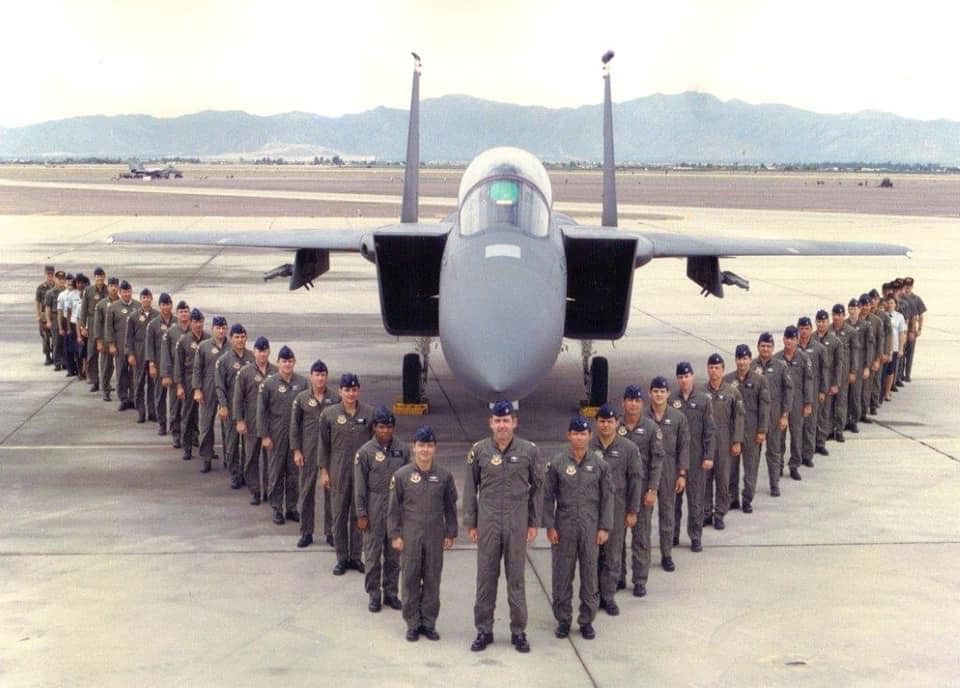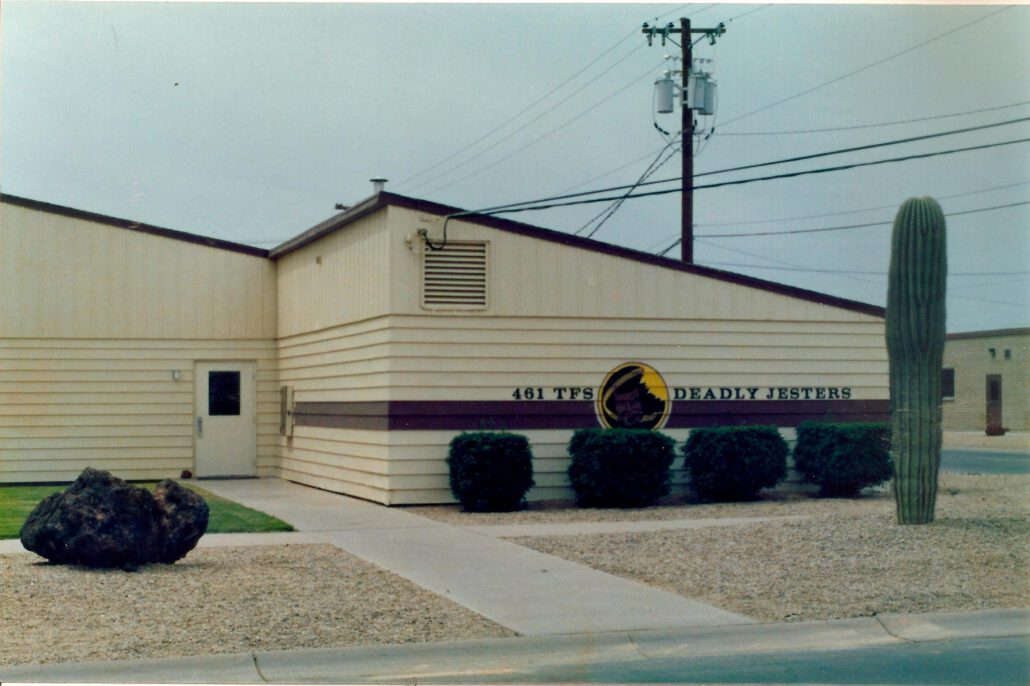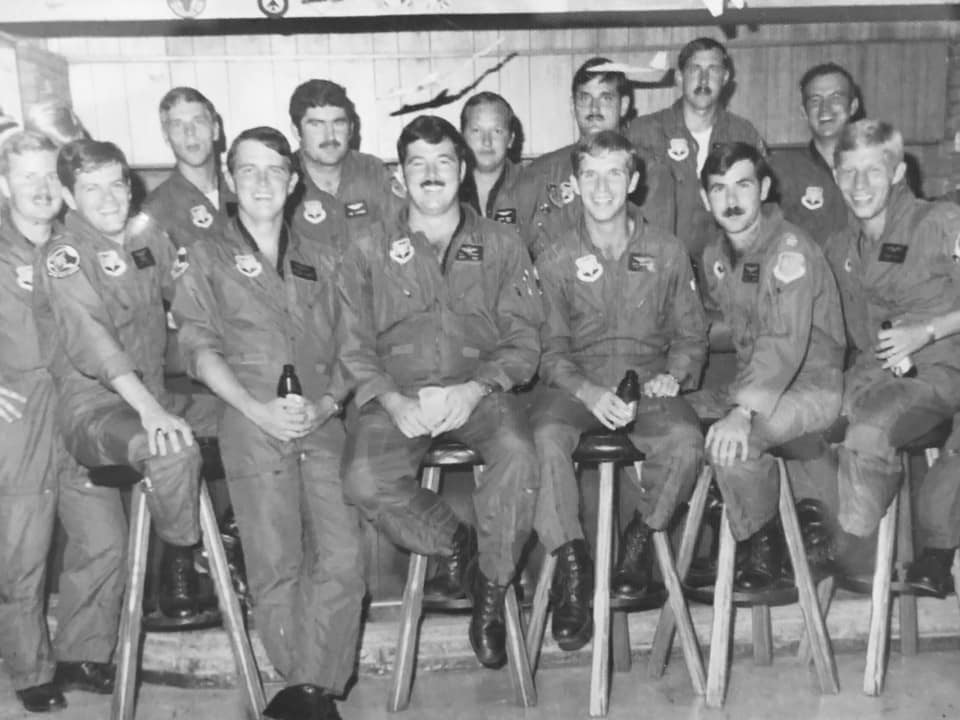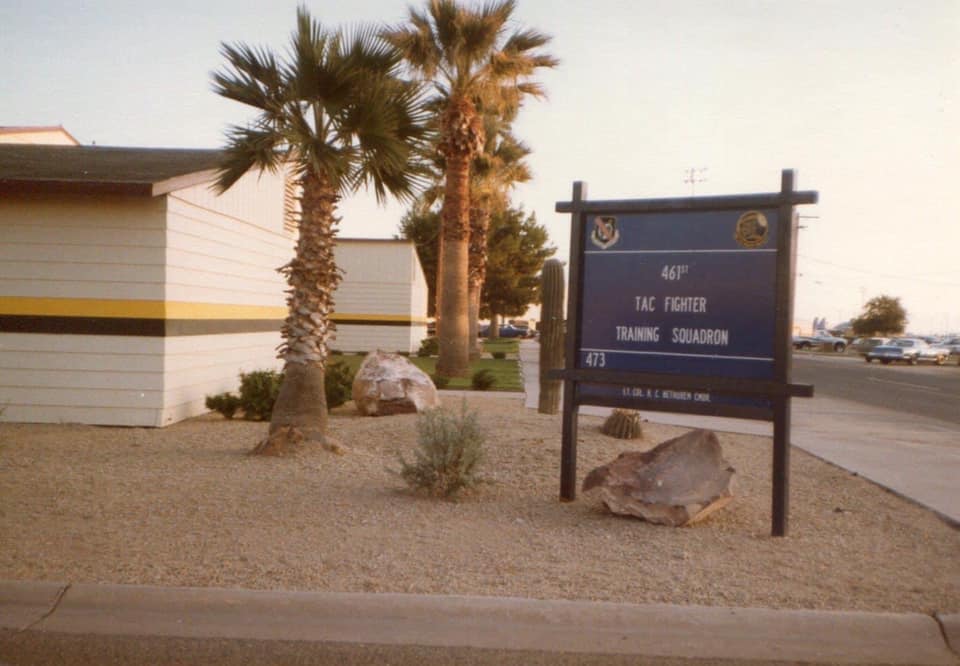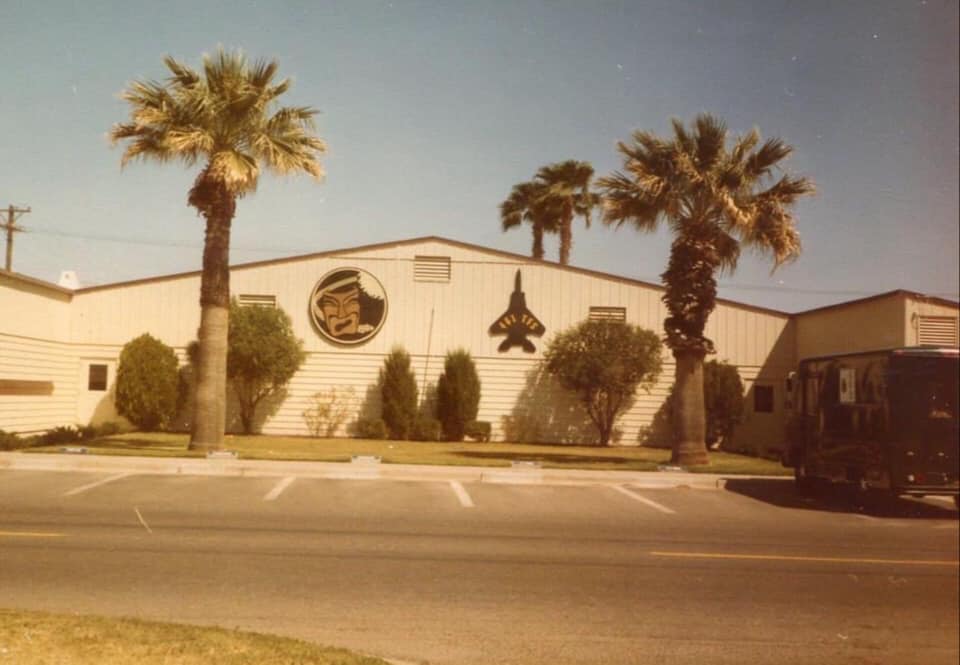The “Deadly Jesters”
Eagle History
On 23 Jun 76, the 461 TFS was activated again and assigned to the 58th Tactical Fighter Training Wing (TTW) at Luke Air Force Base, Arizona. Eighteen of Tactical Air Command’s (TAC’s) finest pilots gathered behind their new commander, Lt Col Jack R. Petry, to receive the squadron colors. By this ceremony, Brig Gen Fred A. Haeffner, Luke’s Wing Commander, signaled the activation of a new training squadron, the rebirth of the 461st. The first Dining‑In was attended by the original members of the 461 FDS in Germany who passed on the squadron scrapbook and other memorabilia.
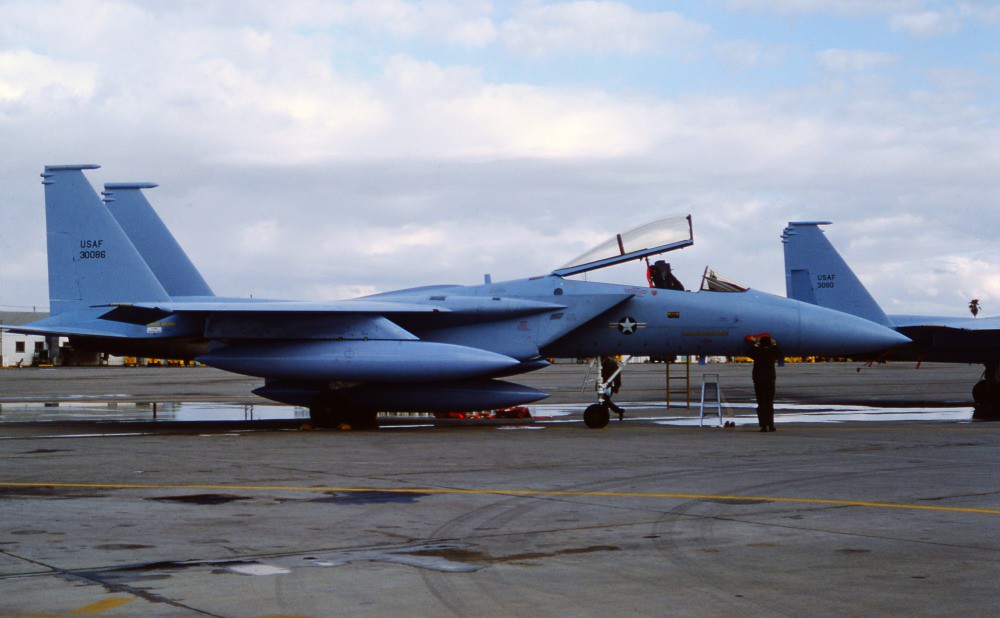
Designated as a Tactical Fighter Training Squadron (TFTS), the 461 TFTS was given the charter of producing the finest fighter pilots in the world to man the world’s finest fighter, the F‑15A. Eighteen of the sleek, grey, twin‑tailed birds were quickly painted with the “Jester” colors.
The outstanding record of the squadron during this period speaks for itself. In its first two years after reactivation, the squadron piled up over 12,000 sorties and 14,000 accident free hours in the process of training America’s finest to fly the F‑15 Eagle. The “Deadly Jesters” routinely won the wing Turkey Shoot and was the first squadron ever to win three in a row.On 28 Jul 78, Lt Col Farrington assumed command of the 461 TFTS. Bringing with him extensive experience in the F‑100 Super Sabre and F‑4 Phantom, Lt Col Farrington achieved instructor proficiency in the Eagle in minimum time and continued the fine tradition of this proud squadron. During the period Jul 78‑Jul 80, the “Deadly Jesters” continued the proud tradition of leading the way. In Jan 79 the 58 TTW began a new maintenance concept in which the fighter squadrons were tied to specific airplanes and a specific Aircraft Maintenance Unit (AMU). The “Deadly Jesters” fine‑tuned this “new” (remember squadron maintenance) concept to perfection. We began seeing maintenance people at Operations (Ops) and pilots wandering around maintenance again, both at work and play. Results were outstanding; four monthly sortie records capped by 513 in Aug 79, 531 sorties over squadron goal in fiscal year 79; highest scheduling effectiveness in wing for calendar year 1979. The 461st Ops/Maintenance team was selected to manage the wing Air Defense exercise for 1980 Management Effectiveness Inspection (MEI), result ‑ 100% launch rate, 100% hack rate. In Oct 79, the 461 TFTS “attempted” the first squadron surge in the student environment. This “attempt” resulted in 69 sorties flown, 54 of which were effective student training missions and 17 birds still mission capable at the end of the day. In other words, the “Deadly Jesters” broke the “you can’t surge in a Replacement Training Unit (RTU) environment” physiological barrier at Luke.
What about the students? The immense success of the 461st Ops/AMU marriage allowed us to train all our students with a 100% on time rate. Additionally, the “Deadly Jesters” assumed training responsibility for 12 additional students from other squadrons. And the instructors? The 461 TFTS maintained the most consistent off‑station DACT program at Luke, flying sorties against AP, USN, USNR, USMC, AFR, and ANG units. Continued excellent maintenance produced three consecutive “Top Overall” trophies in 405 TTW (on 29 Aug 79, the 461 TFTS was reassigned to the 405 TTW) Quarterly Turkey Shoots.
On 11 Jul 80, Lt Col Bates, Jr., succeeded Lt Col Farrington at the helm of the “Deadly Jesters.” He brought with him three years of F‑15 experience, with two of them at 36 TFW in Bitburg.
Under Lt Col Bates’ direction, not only did off‑station DACT continue, but two “firsts” in RTU developments were accomplished. In Jan 81, six aircraft deployed to Eglin AFB for the Weapons System Evaluation Program. Multiple successful firings of AIM‑7Fs, AIM‑9Js, and AIM‑9Ls were accomplished by “Deadly Jester” instructor pilots (IPs). During Mar‑Apr 81, realistic training hit its peak with the 461 TFTS participation in Red/Green Flag. Once again, the Ips and AMU proved the superb combat potential and capability of the F‑15.The “Deadly Jesters” continued to have the highest quality of instructor pilots. Captain Hauck was the second recent member of the squadron to be selected to the Thunderbirds, and Captain Gentrup was selected as “TAC IP of the Year” for 1980. The Australian Royal Air Force (RAF) also sent over their best Mirage pilot, squadron leader, Gerry Keogh, who taught the 461 TFTS Ips and students his “down under” fighter skills.
Social comradery has remained a characteristic Jester trait. In Sep 81, a tremendously successful 461 TFTS reunion was held at the Pointe Resort in Scottsdale, Arizona. Active duty and civilian members from both the F‑86,F‑100, and F‑15 era gathered from all across the country for a typical “Deadly Jester” bash.
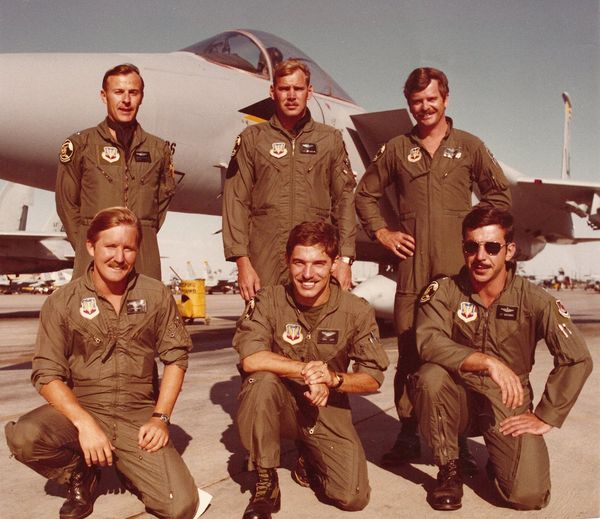
On 18 Jun 82, Lt Col Bethurem assumed command of the “Deadly Jesters.” Lt Col Bethurem’s purely tactical background consists of 1,000 hours of F‑4C/D/E, including 632 combat hours in 385 combat missions in SEA, 650 hours of F‑104G/S and 1,000 hours of F‑15A/B/C/D. The change of command ceremony was highlighted by a 4‑ship “fly‑by” of four of the “Jesters”‘ finest.
Under Lt Col Bethurem’s leadership the “Deadly Jesters” once again shifted into the winning mode. Three more consecutive Turkey Shoots were chalked up, with two individual “Top Gun” awards going to Captains Scott Johnson and Doug Fraser. The Jester maintenance geared up for nine consecutive “AMU of the Month” awards ‑a record for the 405 TTW and a record that will hold, no doubt, for years to come. The 461st Ops/AMU relationship became synonymous with excellence throughout Twelfth Air Force and Tactical Air Command. General Creech, the TAC commander, toured only one fighter squadron at Luke AFB during his Apr 83 visit ‑the 461 TFTS. The squadron became a veritable showplace again after a $100 thousand renovation that resulted in a first class building for a first class squadron. Captain Attarian became the third “Deadly Jester” to become a “Thunderbird.” Captain Knight won the prestigious Anthony C. Shine Award for professional skill and excellence in flying. SSgt Susie Smith was chosen as TAC’s Life Support NCOIC of the Half for Jul‑Dec 82. In Jul 83 the “Deadly Jesters” once again received an exchange pilot ‑ this time from the country where the 461st was activated ‑ Germany. Major Holger Funke and his family joined the “Jesters” for a three and a half year tour.
On 11 May 84, Lt Col James A. Clough assumed command of the 461 TFTS. Lt Col Clough, a former “Deadly Jester” as a flight commander in 1976 when the squadron was reactivated, returned to the squadron with 3,400 fighter hours in the F‑15 and F‑4 including 425 combat missions. The squadron continued to excel in all areas as it participated in two Red Flag exercises, two Cactus Arizona exercises, several Quick Force exercises, Combat Archer, Coronet Springs and Sentry Independence exercises, plus multiple Dissimilar Air Combat exercises, on and off station. The squadron won the Air Division trophy as the best team in the Turkey Shoot competition for F‑15, F‑16, and F‑5 squadrons. The AMU continued its excellent record, winning multiple “AMU of the Month” awards. The fully mission capable rate of the “Jester” jets climbed to an all time high of over 83% for fiscal year 1985. Dignitaries visiting the squadron included General Creech on his farewell tour, General O’Malley on his initial visit, Admiral Lyons (CINC Pacific Fleet), Lt Gen Kelley (Vice Commander of TAC and a former “Deadly Jester”), Lt Gen Cunningham, Maj Gen Messerli, and Maj Gen H. T. Johnson.
Notable personnel achievements included SrA Denis Bechen ‑ 12 AF Life Support Airman of the Quarter, SrA Dane Guynn ‑ 405 TTW Airman of the Month, Ssgt Colleen McHugh ‑ 405 TTW NCO of the Quarter, Captain Bloomfield ‑ 405 TTW Company Grade Officer of the Quarter, and Captain G. Kimpel and Captain S. Anderson ‑ Fighter Weapons School graduates. Lt Col T. Danforth (“Jester” Ops Officer) was selected as 34 TFS Commander at Hill AFB. Lt Col D. Creighton (Asst Ops Officer) became 405th Tactical Training Squadron (TTS) Commander and then moved to 555 TFTS as Commander; Lt Col W. Hodges was selected as 555 TFTS Ops Officer and Major B. Spitzer was selected as 550 TFTS Ops Officer. The “Deadly Jesters”‘ influence is spreading throughout the wing and TAC.
Two noteworthy events occurred. First, an F‑86 painted in “Deadly Jester” colors was put on permanent display recognizing the first “Deadly Jester” commander, Lt Col B. Haning. Second, TAC/USAF/DoD approval was obtained for the use of the call signs “Deadly” and “Jester” for the 461 TFTS. These two historical names are now permanently assigned to the “Deadly Jesters”, where they belong!
On 18 Apr 86, Lt Col R. Mather assumed command of the “Deadly Jesters.” The new “Deadly One” had a pure fighter background in the F‑4C/D/E and F‑15A/B/D. His 2,900 hours of fighter time included 386 hours of combat time in the F‑4 in Southeast Asia; he was a graduate of both the F‑4 and F‑15 FWIC at Nellis AFB where he served as an instructor in the F‑15 program.The squadron’s record of excellence continued as SrA Denis Bechen was selected as the “TAC Life Support Airman of the Quarter” (Jan‑Mar 86) and the AMU pulled down the coveted “AMU of the Month” award for three consecutive months. The “Jesters” maintained their lead in quality continuation training for instructors through numerous successful training deployments to Nellis AFB for exercise Coronet Springs, F‑16 FWIC Dissimilar Air Combat Training and F‑5E Aggressor DACT, Kingsley Field, Oregon for Air National Guard F‑4 DACT, and to Red Flag to fly as both Blue and Red Air. In Dec 86, the “Jesters” deployed to Tyndall AFB to fire live missiles in combat scenarios. Capt M. Budgeon served as the 832nd Air Division Project Officer for exercise Cactus Arizona flown from Luke; the “Jesters” took the lead again. The “Jesters” were privileged to be selected to fly Mr Robert Helm, Assistant Secretary of Defense Comptroller on an F‑15 orientation flight and to be handpicked for a 4‑ship fly‑by at the USAF Academy. Due to a super show in 1986, the “Deadly Jesters” were reinvited for the USAF Air Force Academy’s celebration of the 40th Birthday of the Air Force and POW/MIA Day in Sep 87, where a missing man formation was flown. The 461 TFTS set new highs in professional achievement by pulling down the highest ratings of all the F‑15 squadrons at Luke during a 1986 TAC Inspector General’s MEI. The squadron was rated overall “Excellent”, with excellent program ratings in Leadership and Management, Flight Evaluations, Simulator Evaluations, Flying Training, Ground Training, Weapons and Tactics, Standardization, Programming, and Mobility. The “Jester” Life Support Section earned the honor of being rated “Outstanding” ‑Best Squadron Life Support Section in TAC. In Apr 87, the squadron’s overall talent was recognized when the “Deadly Jesters” received the winning trophy for the 405 TTW Turkey Shoot, an honor which demonstrated that we have maintained the best Ops/AMU team in the wing. The highest quality student training continued, as evidenced by the “Jesters”‘ B‑Course graduate, Lt Scott Stacy, being selected to receive the American Fighter Aces Award for air‑to‑air excellence in an RTU program.
Individual honors continued to flow: Major R. Junge was selected as the Wing Instructor Pilot of the Year for 1987, was runner‑up for 12 AF Flight Commander of the Year and was selected as TAC Instructor Pilot of the Year and TAC nominee for Ten Outstanding Young Americans. Captain Dean Trudeau was the Instructor Pilot of the Quarter from September‑December 1986, Captain K. Lutz was the Wing’s Junior Officer of the Quarter from September‑December 1986.
Awards werereceived by Lt Col Mather (Meritorious Service Medal and Air Force Achievement Medal), Captain R. Shook (Commendation Medal), Lt Col Mike Conner (Meritorious Service Medal), Major Junge (Air Force Achievement Medal), Lt Col Huneycutt (Meritorious Service Medal), Major Funke (German Armed Forces Commendation Cross, Gold), Lt Col Evans (Joint Service Commendation Medal, Overseas Long Tour Ribbon), Captain Alexander (Combat Readiness Medal), Captain Brown (Combat Readiness Medal), Captain Lutz (Air Force Commendation Medal), and Captain Cabriales (Meritorious Service Medal).
Due to continued excellence, the “Deadly Jesters” were selected by the TAC to become the USAF’s first F‑15E squadron. Many activities began including plans for the new “Jester” Ops F‑15E building. Ground breaking ceremonies for building #461 took place on 13 Aug 87, with Col Sherlock, 832 AD/CC, Col Tornow, 405 TTW/CC, and Lt Col Mather, 461 TFTS/CC, presiding. Lt Col R. D. Evans and Lt Col B. Huneycutt were selected as members of the initial cadre of the F‑15E.
From 4‑7 Sep 87, the “Deadly Jesters” continued to display their pride and conducted a squadron reunion in Phoenix. A banquet at the Mountain Shadows resort in Scottsdale and tours, briefings, and a barbecue at the squadron were the highlights of the weekend. As the squadron looks to the future, we continue to focus on our goals of training proficient, disciplined wingmen and instructor pilots in the F‑15; on taking care of people within the organization; on improving the quality of service life and the quality of the force; on continually improving the interface between operations and maintenance; and on improving our proficiency as fighter pilots through quality continuation training.
On 6 Oct 87, Lt Col R. D. Evans assumed command of the 461 TFTS. Lt Col Evans is a career fighter pilot with over 3,300 hours in the F‑100, F‑4, F‑15, T‑38, F‑5, and F‑16. He flew F‑4 combat missions at Udorn, RTAFB in 1973. He is a graduate of the USAF Fighter Weapons Instructor Course and a demonstration pilot for the USAF Demonstration Squadron, Thunderbirds, where he flew as a solo pilot. Lt Col Evans is no stranger to the “Deadly Jesters.” In Jun 76, he was selected as a member of the initial cadre which reactivated the 461st TFTS, where he served as the F‑15 weapons officer and as a flight commander. Lt Col Evans was selected to head the U.S. Air Force’s first F‑15E training program at Luke AFB and to lead the “Deadly Jesters” in the pursuit of excellence with a new primary F‑15E mission of all weather interdiction, including strike and attack.
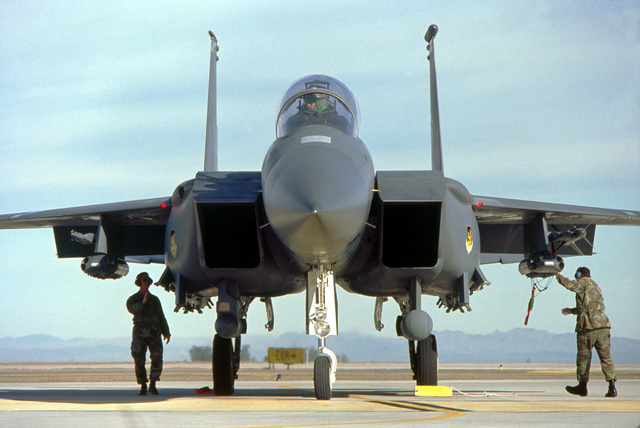
The arrival of the first F‑15E occurred on 12 Apr 88. Piloted by Col R. Tornow, 405 TTW Commander, and Gary Jennings, McDonnell Douglas Chief Test Pilot, the dark grey F‑15E, number 86‑186, landed at Luke after a 2.8 hour flight direct from the factory at St. Louis. “E‑4” flew regularly through May and June, enabling a small contingent of “Jesters” to check out in the newest Eagle, led by “Deadly One”, Lt Col Evans.
On 16 Jul, E‑5 (F‑15E #86‑187), flown by Major T. Branson, Operations Officer, and Major M. Trotter, Assistant Operations Officer, joined the “fleet” at Luke. The USAF’s two newest fighters were immediately configured for their dual roles and placed on static display for the official F‑15E activation ceremony.
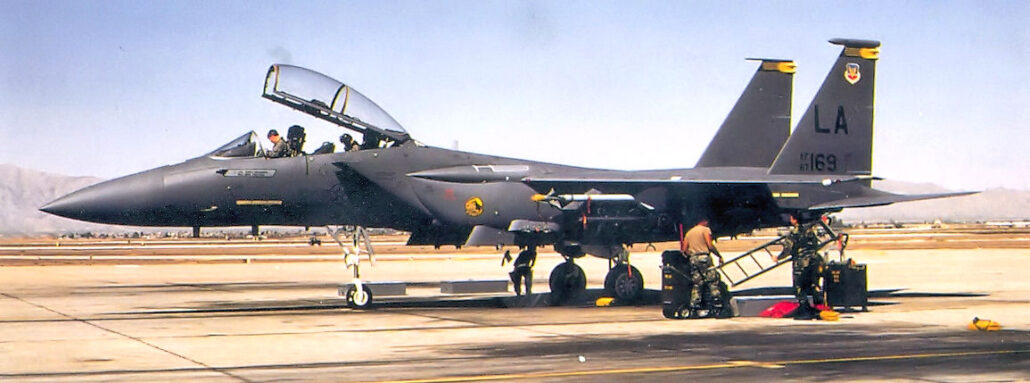
Beginning with a formal dinner on Sunday, 17 Jul, the “Deadly Jesters” celebrated the arrival of their new war machines and welcomed all the new pilots and weapon systems officers to the “Jester Team.” Special guests at this event included General Russ, Commander of TAC, Mr Jim Spear, Vice President of McDonnell Aircraft Company, and representatives from Pratt and Whitney, Hughes Aerospace, and Martin Marietta Aerospace. The highlight of the evening was a presentation of an original oil painting of the E‑4 and E‑5, painted with the wing and the squadron tail numbers, to the wing by Mr Spear.
The formal activation ceremony took place the following morning, 18 Jul 88. Presided over by General Russ, the ceremony included all 461 TFTS and AMU personnel and was a great success. The ceremony culminated with a presentation of a six foot long F‑15E scale model to General Russ by Mr Spear. This model is currently on display in the squadron.
The following weekend brought together “Deadly Jesters”, old and new, as the 461 TFTS hosted a 3‑day “Jester” Reunion. Starting with cocktails, Friday, at the Camelback Inn in Scottsdale, the reunion progressed through the weekend including golf, tennis, swimming, and a formal dinner. The reunion wrapped up the weekend with squadron open house/barbecue/static display in the new building.
The two new Eagles performed superbly under the skilled and careful maintenance of the 461 AMU, racking up a UTE rate of 38 for the month of Sep (both jets flew twice a day, every day). This facilitated the checkout of ten additional aircrews and kept the initial cadre program on track for the arrival of the first crews from Seymour Johnson, signaling the beginning of that wing’s conversion to the F‑15E from the F‑4E. The systems in the jet worked as advertised, allowing the “Jesters” to walk away with two monthly Turkey Shoot awards.
Aircraft deliveries began to pick up and by the time the first class started, 89 ATE, the “Jesters” were up to eight jets, building to a total of fifteen.
On 20 Jan 89, Lt Col S. Bennett assumed command of the “Deadly Jesters.” Lt Col Bennett came to the “Jesters” after having served as squadron commander of the 426 TFTS. Prior to that he served as operations officer of the 525 TFS at Bitburg AB. In addition to the F‑15, Lt Col Bennett has flown the A‑37, 0‑2, and A‑7.
The 461 TFTS continued to gain aircraft and the first F‑15E transition class (TX) graduated on 24 Feb 89. This was ahead of schedule even though aircraft deliveries were way behind schedule. This was a first for the first class in a new weapons system.
The squadron also received its 22nd aircraft in May and it was time to split the squadron in half with one half forming the 550 TFTS as the second F‑15E training squadron.
On 6 Mar 89, the “Jesters” loaded up a four‑ship with 12 M‑82s each ‑ the first F‑15E sorties flow with heavyweight ordnance. The flight flew a 40 minute low level and hit the target right on the mark. Later that month, a Jester two‑ship dropped live bombs for the first time from an F‑15E.
Also in May of 1989, the 461st became the Air Force’s first Low Altitude Navigation and Targeting Infrared for Night (LANTIRN) squadron. In a formal ceremony on 17 May 89, the Air Force accepted the LANTIRN system and gave the first navigation pods to the 461 TFTS. The first F‑15E LANTIRN missions were flown on 22 May and began a new era in night tactics and capabilities. Once again, the 461st took its place in history as the first squadron with a new technology system. Once the “Jesters” qualified, they checked out instructors from the 550 TFTS and from the 4 TFW at Seymour Johnson AFB. LANTIRN tactics, including night low level and weapons delivery, soon became a part of everyday training in the F‑15E.
Under Lt Col Bennett, the squadron continued to build upon its reputation as both a highly social group and as highly skilled aviators. In addition to eye opening performances in the All Aspect Adversary Counter Tactics (AAACT) test at Nellis AFB in Nov of 89, the “Jesters” participated in the first night Red Flag (Red Flag 90‑2) in almost a decade ‑‑ mission results were near perfect. Jester crews set new standards for night interdiction, as they used the F‑15E radar and missile systems to “kill” enemy fighters, while still hitting ground targets on time with great precision.
To top off an unprecedented year of achievement, the 461 TFTS was named the “Top Gun Squadron” for 1989 and received the DO’s annual trophy for highest cumulative place of finish in the monthly 405 TTW Turkey Shoots.
1990 was a year of many “firsts” for the F‑15E. In March, the squadron received its first B course students. Lt H. Waring, flying with Lt Col Bennett in his backseat, became the first Second Lieutenant pilot to fly the F‑15E. A few weeks later, 2LTs J. Mase and G. Watson became the first Second Lieutenant crew in Eagle history.
On 25 May 90, Lt Col H. Disbrow, Jr. assumed command of the “Deadly Jesters.” Lt Col Disbrow came to the “Jesters” after having served as operations officer for the 550 TFTS. In addition to the F‑15E, Lt Col Disbrow flew the T‑38 and F‑15A.
The summer of 1990 got off to a good start with weekend DACT deployments to March AFB and MCAS El Toro, CA. Back at Luke, the Jester B course students who were just beginning to learn the basics of surface attack had no idea how soon they would employ those skills in combat. On August 2, Iraqi tanks rolled into Kuwait, and the United States responded by deploying a vast arsenal of airpower to the Persian Gulf ‑ including the USAF’s newest fighter, the F‑15E. As the former Jester students in the 336 TFS began deploying from Seymour‑Johnson AFB, the “Desert Shield” battlestaff recruited 461st instructors to fill positions in Riyadh, Saudi Arabia. The deployment of the 336 TFS left the 4 TFW with very few experienced instructors, and the Jesters responded by sending the first of many Instructors to assist with training, an on‑going rotation that would continue for over six months.
The Jester B course continued their training with even more intensity than before, culminating in a September graduation exercise that included 8 ship packages carrying inert MK 84s, attacking targets defended by F‑18 adversaries.
Despite the growing threat of war in the Middle East, which had sapped the 461st to less than 70% manning, the business of the Air Force went on. In October, the TAC Inspection team arrived to conduct a Unit Effectiveness Inspection, and the Deadly Jesters earned an “Excellent” rating. As a reward for the hard work of UEI preparation, in early November the Jesters took 6 jets on a 10 day deployment to Ellington Field, TX. By late November, several Jesters had returned from the Middle East. Those that remained were promised a chance to fly regularly with the 4 TFW (Deployed).
November also saw the delivery of the first LANTIRN Targeting Pods to Luke AFB. The Jesters soon began checking out instructors in the use of the pod’s infrared tracker and laser range‑finder. Unfortunately, all pods were soon shipped off to operational squadrons, and it would be many months before checkouts could be completed.
In late December, a second squadron of F‑15Es deployed to Saudi Arabia from Seymour‑Johnson AFB, including eight young aviators who only 3 months earlier had finished a B course in the 461st. At Luke, the men and women of the 461st watched and waited for the debut of the F‑15E in combat. They did not wait long.
On January 16, 1991, the United States and its allies began the most massive air campaign in history. Only minutes after the first bombs hit Baghdad, LtCol K. Trumbull and Maj B. Chamblee, both Jester WSOs, released their bombs on targets in western Iraq. Flying with the 335 TFS “Chiefs”, these two Jesters became the first active 461st members to fly combat missions. Together they would accumulate over 200 hours of combat time during the six weeks of Operation Desert Storm.
As soon as hostilities erupted, four Deadly Jesters began packing their bags for deployment. The 405th TTW had been tasked to provide attrition reserve crews to replace combat losses in the 4th TFW (Deployed). These crews were forward deployed to Seymour‑Johnson AFB, N.C., but due to the unexpectedly low losses in Operation Desert Storm, they returned to Luke just two weeks later.
The reality of war did not stop regular training. Just four days after the war began, the 461st deployed 3 jets to participate in Red Flag 91‑2 at Nellis AFB, NV. The second night Red Flag for the Jesters, it was another resounding success.
By mid‑March, the last Jesters had returned from duty in the middle east. The new combat veterans highlighted the welcome home party by opening a “time capsule”. Left by Class 85‑GBL, the wax‑sealed wicker basket was marked with a brass plaque reading “To Be Opened By The First Jester Returning From Combat”. Lt Col K. Trumbull and Majors B. Chamblee and Gary Green did the honors, revealing a 1985 copy of Playboy (the last stapled edition), an expensive cigar, and a bottle of “Eagle Rare” bourbon. The bottle sufficed for one toast to the foresight of that class, and the heroic efforts of the first Jesters tested under fire.
March 1991 marked the departure of Lt Col M. Bumpas, who left his post as 461st Operations Officer to become the first commander of the F‑15E Division of the USAF Fighter Weapons School at Nellis AFB. Drawing on the proven talent pool of the 461st, the Fighter Weapons School also selected Majors J. Parker and combat veteran, B. Chamblee as members of the FWIC Initial Cadre.
March 1991 also brought the arrival of the newest member of the squadron. Class 91‑BTE presented the squadron with a six‑week old beagle. He was christened DJ (for Deadly Jester) and soon became a fixture in the squadron.

In October 1991, as a part of an Air Force‑wide reorganization, the two wings of the 832nd Air Division united into the 58th Fighter Wing (FW) and the Deadly Jesters became the 461st Fighter Squadron (FS). Under this reorganization, the squadron’s aircraft maintenance unit (AMU) was now directly under the command of the 461 FS squadron commander. The Life Support section moved into an adjacent building to allow operations to expand the flight planning room and house the growing number of flight planning computers. New offices in the squadron building were the chief of maintenance, maintenance plans & scheduling, and orderly room.
In December 1991, HQ TAC shifted responsibilities for phase inspections from the Logistics Group to the Operations Group. Accordingly, the 461 FS added an inspection flight to its squadron maintenance.
On 6’December 1991, Lt Col S. Spencer assumed command as the Jesters’ fifteenth squadron commander. Lt Col Spencer had served as the 58 FW Chief of Safety. Prior to that, Lt Col Spencer had served as Operations Officer for the 550 TFTS at Luke. His flying experience includes the F‑4E and F‑15A/C.
1991 came to a close with the 461 FS having won several significant awards. Overall, the squadron won the Frank Luke Trophy as the 58 FW’s Outstanding Fighter Squadron. The 461 AMU flew the flag as the 405 TTW’s AMU of the Year and their phase inspection facility earned the Phase Dock of the Year Award. Tsgt Joseph Brengman was selected as the 58 FW Maintenance Professional of the Year. The quality of instructors flying in the Jesters was highlighted when TAC selected Capt W. Delgrego as the F‑15E Instructor Pilot of the Year and Capt L. Berrena as the F‑15E Instructor Weapons Systems Officer of the Year.
The Jesters’ first off‑station deployment in over a year took place in March 1991 when the squadron deployed six aircraft to Yuma Marine Corps Air Station (MCAS), AZ. The 461 FS F‑15Es acted as “Red Air,” attacking radar sites with simulated laser guided bombs while defending against F/A‑18s and numerous ground threats in the Marine integrated air defense network. The ability of the F‑15Es to hit pinpoint targets while shooting down F/A‑18s impressed the Marine commanders and all other players in the exercise.
The following month, the Jesters deployed four aircraft to Mountain Home AFB, ID, to drop laser guided bombs (LGBs) on Saylor Creek range. This was the squadron’s first opportunity to drop LGBs and designate the point of impact with a laser spot from the aircraft’s LANTIRN targeting pod. All four of the inert, 500 lb bombs hit within a few feet of their designated aimpoints. The following day, four more aircraft dropped LGBs on the Gila Bend ranges and again the results were just as impressive.
The 461st Fighter Squadron was inactivated on August 5th 1994, as part of the relocation from the F-15E aircrew training to Seymour-Johson AFB.
Squadron Photos
